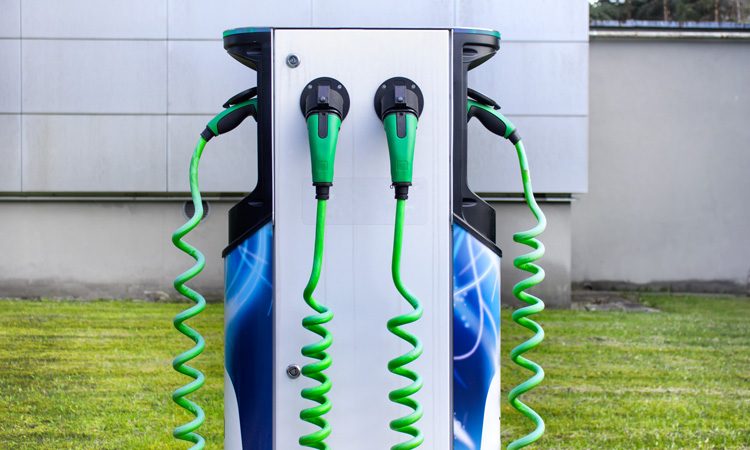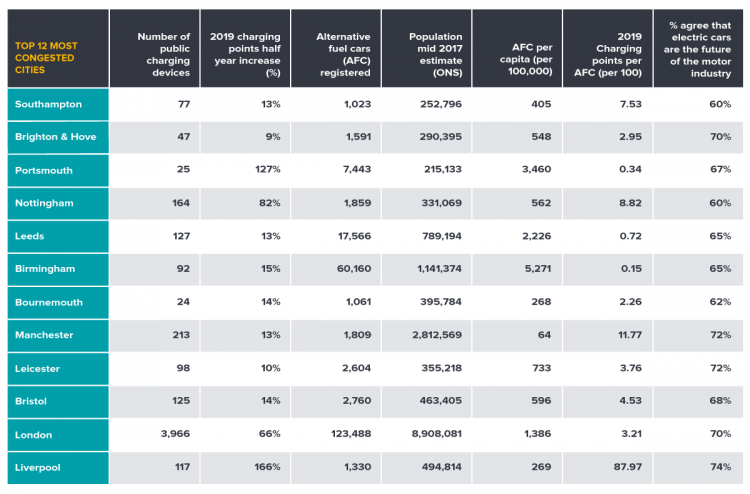Best-prepared UK cities for switch to EVs revealed
- Like
- Digg
- Del
- Tumblr
- VKontakte
- Buffer
- Love This
- Odnoklassniki
- Meneame
- Blogger
- Amazon
- Yahoo Mail
- Gmail
- AOL
- Newsvine
- HackerNews
- Evernote
- MySpace
- Mail.ru
- Viadeo
- Line
- Comments
- Yummly
- SMS
- Viber
- Telegram
- Subscribe
- Skype
- Facebook Messenger
- Kakao
- LiveJournal
- Yammer
- Edgar
- Fintel
- Mix
- Instapaper
- Copy Link
Posted: 23 September 2019 | Intelligent Transport
Only 2 per cent of registered vehicles in the UK were low emission in 2018, according to a Department for Transport report.


New research has suggested that Southampton is the UK’s best-prepared city for the switch to electric cars, with London ranking outside the top 10 based on the number of charging points installed compared to its overall population.
Based on calculations that consider factors such as the population, the amount of public charging points and their increase rate since January 2019, as well as the volume of alternative fuel cars currently registered, the research revealed that Southampton will be first to be ready for the electric transition.
The southern city currently has 77 charging points, a 13 per cent increase since January, alongside a relatively low population compared to other major cities, and 1,023 alternatively-fuelled cars registered.
The research, conducted by Euro Car Parts, looked at the UK as a whole, as well as specifically evaluating the capital and the UK’s 10 most congested cities outside of London, to see how prepared they are to make the switch to electric vehicles.
With £2.5 million being invested into electric car charging points by the government, new research has revealed the UK could hit the 2050 target of ‘most vehicles on the road being low emission’, as early as 2034, but the British public has expressed concerns about making the switch.
London has seen a 66 per cent increase in charging points since the start of the year to almost 4,000, but due to its population (9 million) and number of electric vehicles already on the road (123 thousand), it was noted to still require further attention to completely be ready for the electric takeover.
Here are the UK’s most congested cities in order of how ready they are for the electric takeover:


Credit: Euro Car Parts
Year-on-year (YoY) growth shows that the UK has had a 37 per cent increase in low emission cars since 2016. If it continues at this rate, the UK will have 38.2 million low emission vehicles on the road by 2034, meaning the government could hit its 2050 target 16 years early, according to the research.
Despite this, the research also suggests that the nation’s drivers are not as ready to transition to electric as other research has stated.
The research surveyed 2,000 UK drivers who highlighted that ‘not enough charging points’ and ‘being stranded without charge or accessibility to charging services’ were their main concerns (66 per cent), while YouGov statistics show that only 2 per cent would consider purchasing an electric car as their next vehicle.
The UK has seen an average of 28 per cent increase in charging points installed YoY since 2016. If this rate continues, the UK is expected to have 322 public charging points per 10,000 low emission vehicles by 2034, suggesting the UK’s roads will not be fully equipped for the transition, and may not meet day-to-day demand.
The distance-per-charge was also a concern for half of motorists (47 per cent), as well as their electricity bills increasing (27 per cent) and it actually being more costly than owning a petrol/diesel vehicle (22 per cent).
Chris Barella, Digital Services Director at Euro Car Parts, said: “It is interesting to see that while figures suggest the government are on track to hit their low emission vehicle target, perhaps even earlier than anticipated, the nation’s views and attitudes towards alternative fuel vehicles, means we still have a long way to go.
“It seems the biggest concern is the number of charging points and it’s understandable why. If the YoY figures are anything to go by, we simply won’t be equipped to supply the demand, however it is encouraging the government is increasing its funding for charging points in residential areas. Hopefully seeing more around the country will inspire the nation’s drivers to make the switch and help us to achieve the initiative as early as predicted.”
Related topics
Alternative Power, Fleet Management & Maintenance, Infrastructure & Urban Planning, Sustainable Urban Transport, Travel & Passenger Information
Related modes
Electric Transport
Related cities
UK
Related organisations
Euro Car Parts, YouGov
Related people
Chris Barella







